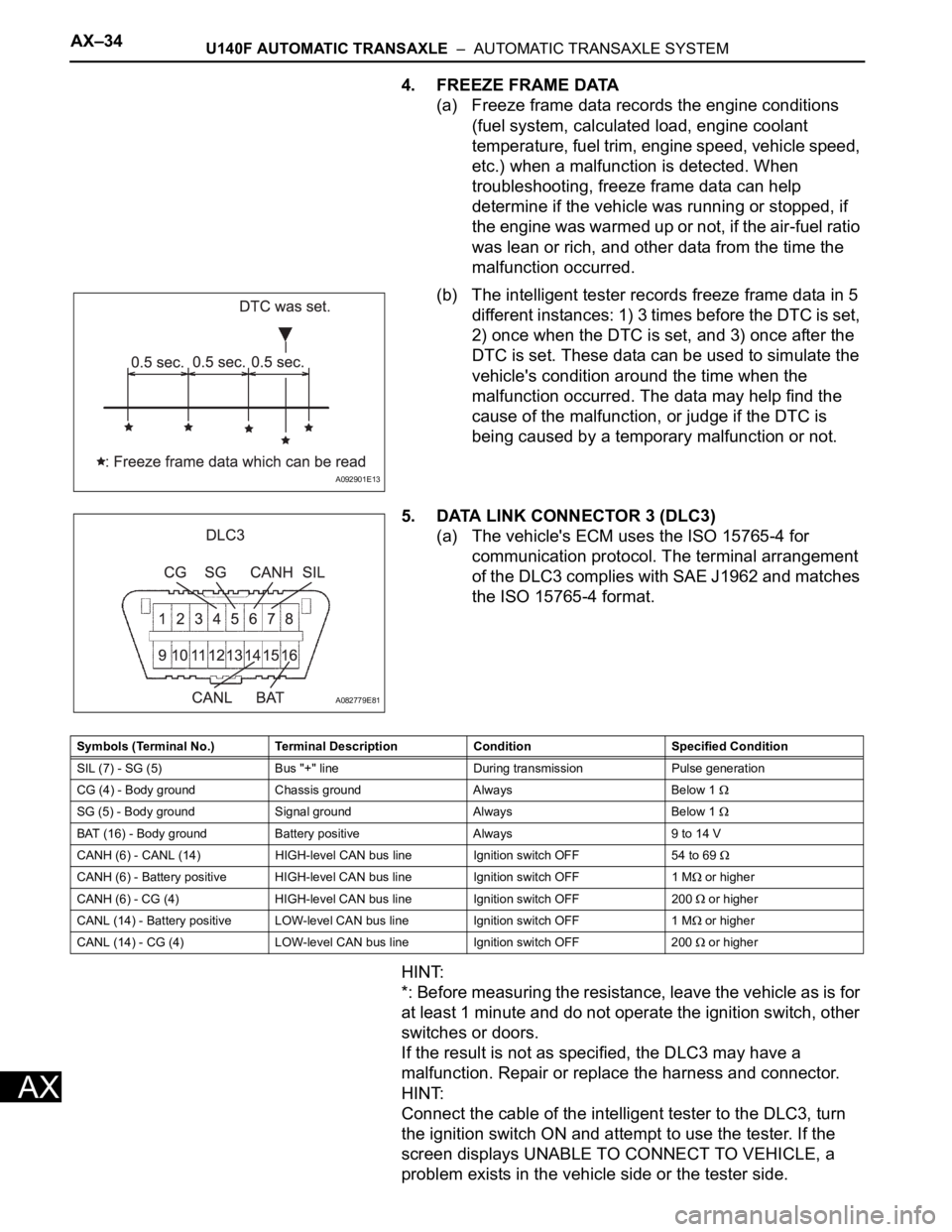Page 859 of 2000
2GR-FE COOLING – THERMOSTATCO–19
CO
REMOVAL
1. REMOVE FRONT WHEEL RH
2. REMOVE NO. 1 ENGINE UNDER COVER (See page
EM-21)
3. REMOVE ENGINE UNDER COVER REAR RH (See
page EM-21)
4. REMOVE FRONT SUSPENSION MEMBER
REINFORCEMENT RH (See page EM-7)
5. DRAIN ENGINE COOLANT (See page CO-8)
6. REMOVE V-BANK COVER SUB-ASSEMBLY (See
page EM-21)
7. REMOVE RADIATOR SUPPORT OPENING COVER
(See page EM-22)
8. REMOVE RADIATOR RESERVOIR TANK
(a) Remove the 2 bolts and radiator reservoir.
9. REMOVE FAN AND GENERATOR V BELT (See page
EM-8)
10. REMOVE ENGINE MOUNTING INSULATOR RH
(a) Remove the 5 bolts, 2 nuts and engine mounting
insulator RH.
11. REMOVE FRONT NO. 1 ENGINE MOUNTING
BRACKET LH (See page CO-12)
12. REMOVE NO. 2 IDLER PULLEY SUB-ASSEMBLY
(a) Remove the bolt, No. 2 idler pulley cover plate and
No. 2 idler pulley.
13. DISCONNECT NO. 2 RADIATOR HOSE
A132441E01
A136837
A094887E01
Page 862 of 2000
CO–222GR-FE COOLING – THERMOSTAT
CO
8. INSTALL RADIATOR RESERVOIR TANK
(a) Install the radiator reservoir with the 2 bolts.
Torque: 5.0 N*m (51 kgf*cm, 44 in.*lbf)
9. INSTALL RADIATOR SUPPORT OPENING COVER
(See page EM-42)
10. INSTALL V-BANK COVER SUB-ASSEMBLY (See
page EM-42)
11. ADD ENGINE COOLANT (See page CO-8)
12. CHECK FOR ENGINE COOLANT LEAKAGE (See
page CO-1)
13. INSTALL FRONT SUSPENSION MEMBER
REINFORCEMENT RH (See page EM-9)
14. INSTALL ENGINE UNDER COVER REAR RH (See
page EM-41)
15. INSTALL NO. 1 ENGINE UNDER COVER (See page
EM-41)
16. INSTALL FRONT WHEEL RH
A132441E01
Page 865 of 2000
CO–362GR-FE COOLING – RADIATOR
CO
REMOVAL
1. DISCONNECT CABLE FROM NEGATIVE BATTERY
TERMINAL
CAUTION:
Wait at least 90 seconds after disconnecting the
cable from the negative (-) battery terminal to
prevent airbag activation.
2. REMOVE BATTERY CLAMP SUB-ASSEMBLY (See
page ST-6)
3. REMOVE BATTERY INSULATOR
4. REMOVE BATTERY
5. REMOVE NO. 1 ENGINE UNDER COVER (See page
EM-21)
6. DRAIN ENGINE COOLANT (See page CO-8)
7. REMOVE V-BANK COVER SUB-ASSEMBLY (See
page EM-21)
8. REMOVE RADIATOR SUPPORT OPENING COVER
(See page EM-22)
9. REMOVE RADIATOR GRILLE SUB-ASSEMBLY (See
page ET-6)
10. DISCONNECT HOOD LOCK SWITCH CONNECTOR
11. DISCONNECT NO. 1 WATER BY-PASS HOSE
(a) Disconnect the hose from the radiator reservoir.
12. DISCONNECT NO. 5 WATER BY-PASS HOSE
(a) Disconnect the hose from the radiator.
13. REMOVE NO. 1 WATER BY-PASS PIPE
(a) Disconnect the pipe from the No. 1 radiator hose.
A112308
Page 872 of 2000
2GR-FE COOLING – RADIATORCO–43
CO
15. CONNECT NO. 5 WATER BY-PASS HOSE
(a) Connect the by-pass hose to the radiator.
16. CONNECT NO. 1 WATER BY-PASS HOSE
(a) Connect the by-pass hose to the radiator reservoir.
17. CONNECT HOOD LOCK SWITCH CONNECTOR
18. INSTALL RADIATOR GRILLE SUB-ASSEMBLY (See
page ET-10)
19. INSTALL BATTERY
20. INSTALL BATTERY INSULATOR
21. INSTALL BATTERY CLAMP SUB-ASSEMBLY (See
page ST-15)
22. CONNECT CABLE TO NEGATIVE BATTERY
TERMINAL
23. INSTALL RADIATOR SUPPORT OPENING COVER
(See page EM-42)
24. INSTALL V-BANK COVER SUB-ASSEMBLY (See
page EM-42)
25. ADD ENGINE COOLANT (See page CO-8)
26. CHECK FOR ENGINE COOLANT LEAKS (See page
CO-1)
A114357E03
A112308
Page 949 of 2000

U140F AUTOMATIC TRANSAXLE – AUTOMATIC TRANSAXLE SYSTEMAX–15
AX
ROAD TEST
1. PROBLEM SYMPTOM CONFIRMATION
(a) Based on the result of the customer problem
analysis, try to reproduce the symptoms. If the
problem is that the transaxle does not shift up, shift
down, or the shift point is too high or too low,
conduct the following road test referring to the
automatic shift schedule and simulate the problem
symptoms.
2. ROAD TEST
NOTICE:
Perform the test at the normal operating ATF
temperature of 50 to 80
C (122 to 176F).
(a) D position test
Move the shift lever to D and fully depress the
accelerator pedal. Check the following:
(1) Check up-shift operation.
Check that the 1
2, 2 3 and 3 O/D up-
shifts take place at the shift point shown in the
automatic shift schedule (see page SS-55).
HINT:
O/D Gear Up-shift Prohibition Control
• Engine coolant temperature is 55
C (131F)
or less and vehicle speed is at 70 km/h (43
mph) or less.
• ATF temperature is 5
C (41F) or less.
O/D Gear Lock-up Prohibition Control
• Brake pedal is depressed.
• Accelerator pedal is released.
• Engine coolant temperature is 60
C (140F)
or less.
(2) Check for shift shock and slip.
Check for shock and slip at the 1
2, 2 3 and
3
O/D up-shifts.
(3) Check for abnormal noise and vibration.
Check for abnormal noise and vibration when
up-shifting from 1
2, 2 3 and 3 O/D while
driving with the shift lever on D, and check while
driving in the lock-up condition.
HINT:
The check for the cause of abnormal noise and
vibration must be done thoroughly as it could
also be due to loss of balance in the differential,
torque converter clutch, etc.
(4) Check kick-down operation.
While driving the vehicle in the 2nd, 3rd and O/D
gears with the shift lever on D, check that the
possible kick-down vehicle speed limits for 2
1, 3
2 and O/D 3 kick-downs conform to
those indicated in the automatic shift schedule
(see page SS-55).
(5) Check for abnormal shock and slip at kick-down.
Page 958 of 2000

AX–24U140F AUTOMATIC TRANSAXLE – AUTOMATIC TRANSAXLE SYSTEM
AX
MONITOR DRIVE PATTERN
1. TEST MONITOR DRIVE PATTERN FOR ECT
CAUTION:
Perform this drive pattern on a level surface and
strictly observe the posted speed limits and traffic
laws while driving.
HINT:
Performing this drive pattern is one method to simulate
the ECT's malfunction detection conditions.
The DTCs may not be detected through ordinary,
everyday driving. Also, DTCs may not be detected
through this drive pattern.
(a) Preparation for driving
(1) Warm up the engine sufficiently (engine coolant
temperature is 60
C (140F) or higher).
(2) Drive the vehicle when the atmospheric
temperature is -10
C (14F) or higher.
Malfunction is not detected when the
atmospheric temperature is less than -10
C
(14
F).
(b) Drive pattern
(1) Drive the vehicle through all the gears.
St o p
1st 2nd 3rd O/D O/D (lock-up
ON).
(2) Repeat the above drive pattern 3 times or more.
NOTICE:
• When using the intelligent tester, the
monitor status can be found in
"ENHANCED OBD II / DATA LIST" or under
"CARB OBD II".
• In the event that the drive pattern must be
interrupted (due to traffic conditions or
other factors), the drive pattern can be
resumed and, in most cases, the monitor
can be completed.
CAUTION:
Perform this drive pattern on a level road as
much as possible and strictly observe the
posted speed limits and traffic laws while
driving.
Page 960 of 2000

AX–26U140F AUTOMATIC TRANSAXLE – AUTOMATIC TRANSAXLE SYSTEM
AX
PROBLEM SYMPTOMS TABLE
HINT:
• Use the table below to help determine the cause of the
problem symptom. The potential causes of the symptoms
are listed in order of probability in the "Suspected area"
column of the table. Check each symptom by checking the
suspected areas in the order they are listed. Replace parts
as necessary.
• The Matrix Chart is divided into 2 chapters. When
troubleshooting, check Chapter 1 first. If instructions are
given in Chapter 1 to proceed to 2, proceed as instructed.
• If the instruction "Proceed to next circuit inspection shown
in problem symptoms table" is given in the flowchart for
each circuit, proceed to the next suspected area in the
table.
• If the problem still occurs even though there are no
malfunctions in any of the circuits, check the ECM and
replace it if necessary.
CHAPTER 1: ELECTRICAL CIRCUIT MATRIX CHART
HINT:
*: When the circuit is defective, a DTC may be output.
CHAPTER 2: ON-VEHICLE REPAIR AND OFF-VEHICLE REPAIR
Symptom Suspected area See page
No up-shift (1st -> 2nd) ECMIN-37
No up-shift (2nd -> 3rd) ECMIN-37
No up-shift (3rd -> O/D)1. Park/Neutral position switch circuit*AX-39
2. ECMIN-37
No down-shift (O/D -> 3rd) ECMIN-37
No down-shift (3rd -> 2nd) ECMIN-37
No down-shift (2nd -> 1st) ECMIN-37
No lock-up or no lock-up off ECMIN-37
Shift point too high or too low ECMIN-37
Up-shift to O/D from 3rd while shift lever is on 31. Park/Neutral position switch circuit*AX-39
2. ECMIN-37
Up-shift to O/D from 3rd while engine is cold1. Engine coolant temp. sensor circuit*ES-51
2. ECMIN-37
Harsh engagement (N -> D) ECMIN-37
Harsh engagement (lock-up) ECMIN-37
Harsh engagement (any driving position) ECMIN-37
Poor acceleration ECMIN-37
Engine stalls when starting off or stopping ECMIN-37
Malfunction in shifting1. Park/Neutral position switch circuit*AX-39
2. ECMIN-37
Symptom Suspected area See page
Vehicle does not move in all positions other than P and
N1. Manual valveAX-155
2. Primary regulator valveAX-155
3. Front and rear planetary gearAX-155
4. U/D planetary gearAX-155
5. F2 U/D one-way clutchAX-155
6. C1 forward clutchAX-155
7. B3 U/D brakeAX-155
Page 968 of 2000

AX–34U140F AUTOMATIC TRANSAXLE – AUTOMATIC TRANSAXLE SYSTEM
AX
4. FREEZE FRAME DATA
(a) Freeze frame data records the engine conditions
(fuel system, calculated load, engine coolant
temperature, fuel trim, engine speed, vehicle speed,
etc.) when a malfunction is detected. When
troubleshooting, freeze frame data can help
determine if the vehicle was running or stopped, if
the engine was warmed up or not, if the air-fuel ratio
was lean or rich, and other data from the time the
malfunction occurred.
(b) The intelligent tester records freeze frame data in 5
different instances: 1) 3 times before the DTC is set,
2) once when the DTC is set, and 3) once after the
DTC is set. These data can be used to simulate the
vehicle's condition around the time when the
malfunction occurred. The data may help find the
cause of the malfunction, or judge if the DTC is
being caused by a temporary malfunction or not.
5. DATA LINK CONNECTOR 3 (DLC3)
(a) The vehicle's ECM uses the ISO 15765-4 for
communication protocol. The terminal arrangement
of the DLC3 complies with SAE J1962 and matches
the ISO 15765-4 format.
HINT:
*: Before measuring the resistance, leave the vehicle as is for
at least 1 minute and do not operate the ignition switch, other
switches or doors.
If the result is not as specified, the DLC3 may have a
malfunction. Repair or replace the harness and connector.
HINT:
Connect the cable of the intelligent tester to the DLC3, turn
the ignition switch ON and attempt to use the tester. If the
screen displays UNABLE TO CONNECT TO VEHICLE, a
problem exists in the vehicle side or the tester side.
A092901E13
A082779E81
Symbols (Terminal No.) Terminal Description Condition Specified Condition
SIL (7) - SG (5) Bus "+" line During transmission Pulse generation
CG (4) - Body ground Chassis ground Always Below 1
SG (5) - Body ground Signal ground Always Below 1
BAT (16) - Body ground Battery positive Always 9 to 14 V
CANH (6) - CANL (14) HIGH-level CAN bus line Ignition switch OFF 54 to 69
CANH (6) - Battery positive HIGH-level CAN bus line Ignition switch OFF 1 M or higher
CANH (6) - CG (4) HIGH-level CAN bus line Ignition switch OFF 200
or higher
CANL (14) - Battery positive LOW-level CAN bus line Ignition switch OFF 1 M
or higher
CANL (14) - CG (4) LOW-level CAN bus line Ignition switch OFF 200
or higher